There is a huge range of tools of different formats for applying and leveling finishing plaster mixtures. In this segment, you can find both the classic universal triangular trowel and the elongated rule for working with large areas without placing beacons. But if the emphasis is on the accuracy and accuracy of leveling the mortar on the surfaces of a small room, then a plaster trowel will be the best solution.
Features of Venetian plaster
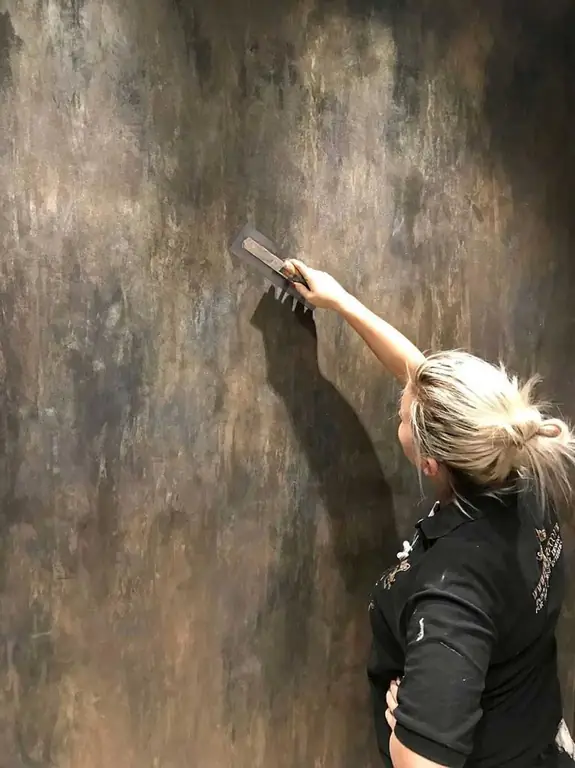
The second name of the tool - the Venetian trowel - comes from a variety of Venetian finishing mortars. The design of the trowel is just right for working with such coatings. A feature of this type of plaster is marbled stylization with a glossy and smooth surface. Venetian devicethe trowel, the photo of which is presented above, just allows you to perform even laying with a relief tolerance of up to 1 mm. As for the plaster itself, it is based on stone dust - usually marble. But crumbs of malachite, onyx, limestone and quartz with granite can also be used. It is the inclusions of natural stone grains that create the original decorative effect of the surface. Hydrated lime is used as a binder according to the classic recipe, although nowadays it is increasingly being replaced by pure or modified acrylates.
Tool design
Outwardly, the tool is not much different from a conventional spatula. The fundamental difference can be seen only in the details, but they just cause a special operational effect. The basis of the plaster trowel is formed by two components - the working metal part and the holder-handle. The first is made of high-strength stainless steel, and the handle is made of plastic or wood. If we talk about the differences, then the worksheet is usually large and rectangular in shape. The second feature is the presence of teeth - both at the top and on the sides. Smooth edges allow for accurate alignment and smoothing of the plaster composition, and the teeth are designed to prepare the solution for the installation of tiled materials. The serrations can form a wave that provides an adhesive grip when continuous laying finishes with a flat surface. There are also models with only smooth edges.
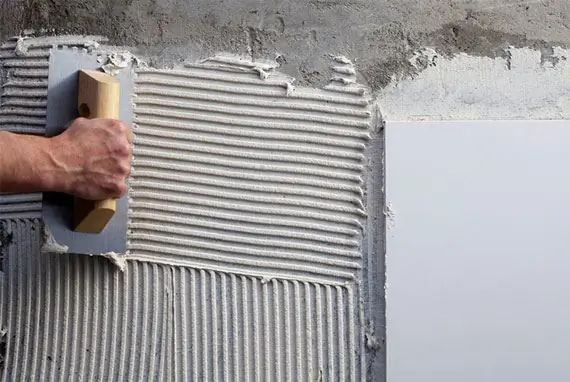
Dimensional parameters
Against the background of other tools designed for laying primer and plaster mixtures, trowels can be positioned as large-format. But in this class there is a gradation in size:
- Width of the working part - from 120 to 270 mm.
- The length of the working part is from 130 to 480 mm.
- Tooth height - 4-6 mm on average.
- Tool weight - from 0.3 to 0.8 kg.
The standard size of the Venetian trowel is 130 x 270 mm - respectively, in width and length. This is the optimal size for domestic use, which is suitable for laying both Venetian and ordinary plaster.
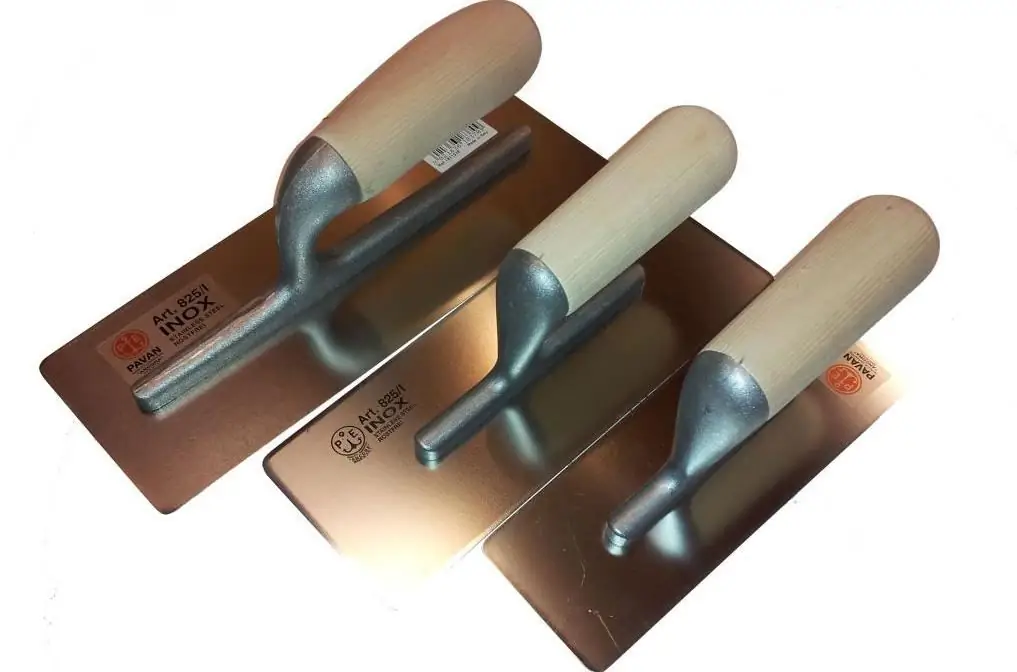
Technique for laying and distributing mix
The prepared mortar is applied to the trowel using a small trowel. The mixture should be distributed in such a way that the same thickness is formed on all parts of the surface. To do this, the trowel must be brought close to the wall at a small sharp angle and gently led to the side or up, distributing the mixture. To provide additional adhesion to the future lining, a toothed Venetian trowel is used. With your own hands, you can create a relief effect with any comb device, passing it over a flat surface. But the best effect can be achieved only when using a trowel with serrated edges. It is usually used to smooth tile adhesive, placing the work area at an angle of 30 ° relative to the surface of the base. To create a relief, you should apply a little effort when moving the tool. The moreangle, the deeper the comb on the surface of the mixture - the range varies from 25 to 75 degrees. In one pass, plasterers are advised to lay no more than 1 m2 of the composition, since it will not be possible to level a large area in time due to the limited polymerization (hardening) period.
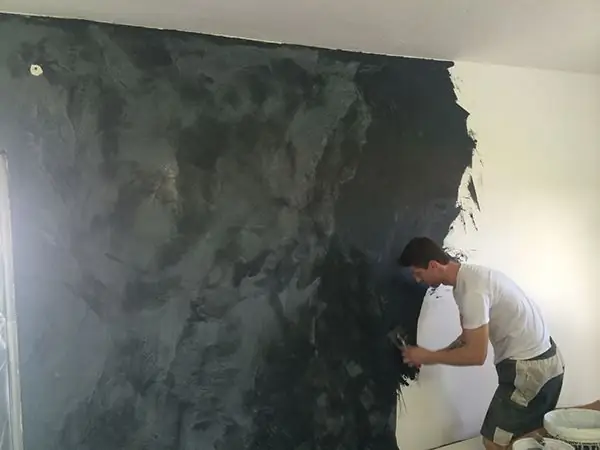
Smoothing plaster
This operation is performed after laying the upper main layer of plaster, the thickness of which is 3-5 mm. A feature of the working technique when smoothing the coating will be the application of the trowel with the entire working plane to the wall. The laid layer is first trimmed with a wooden trowel, and then a metal plaster trowel is put into operation with movements in straight directions without circles. The pressure is adjusted so that no pressure is felt inward, but at the same time the effect of smoothing on the sides is provided. First, the trowel moves from bottom to top, and then horizontally. In the case of a ceiling, the instrument is first oriented transverse to the direction of the sun's rays from the window, and then it is drawn along. This approach will eliminate small shadows that will fall on the plaster in natural light.
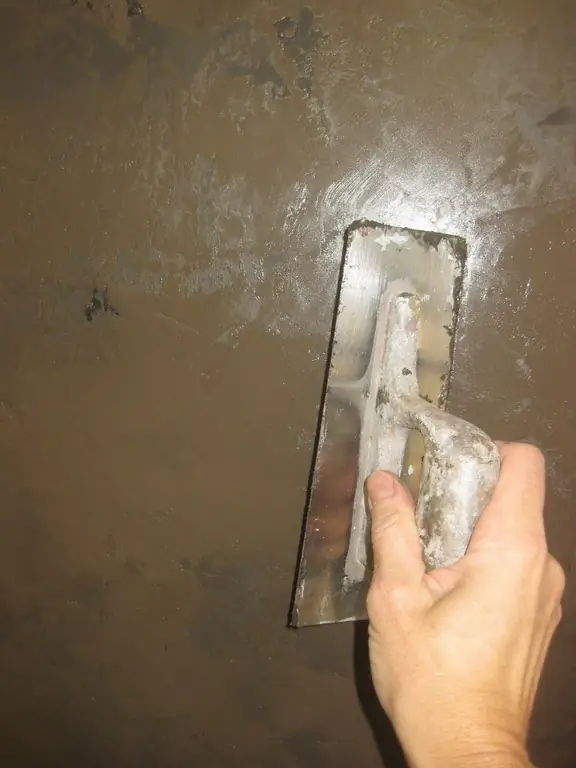
Elimination of minor defects
In this part of the work, in principle, it is recommended to use tools with a rubber working part, since the mechanical action should be extremely soft and delicate. At the same time, it is desirable to preserve the large size of the tooling, which is typical formetal plastering trowel. Such models are rare, but you can find them. So, the task will be to spot seal the recesses, cracks and crevices that remain after the final smoothing. It turns out a kind of disguise, which is desirable to perform a plastic and fluid composition. The base of the trowel is applied to the starting point of the defect and pressed. Next, slowly guide the tool along the entire seam line. Downforce should be completely absent. The main thing is to bring enough solution into the gap to fill it. At the next stage, using the same execution technique, excess solution is removed on the surface of the problem area.
Features of working with decorative coatings
Working with decorative plaster compositions is different in that the installation is performed without leveling before the final cladding. That is, the formation of a relief with teeth is not required at all, but it will be necessary to create the effect of a pronounced texture. So, with the help of a wide Venetian trowel, a needle-like rough surface is created on a freshly applied plaster coating. This effect is achieved in the following way: a trowel is completely applied to the laid and leveled mortar, after which it is abruptly torn off. In the process of separation, small grooves with solution needles are formed. So that the protruding texture does not break off and retains its shape, you should initially choose a dry mix on special granules with the same interspersed with natural stone.
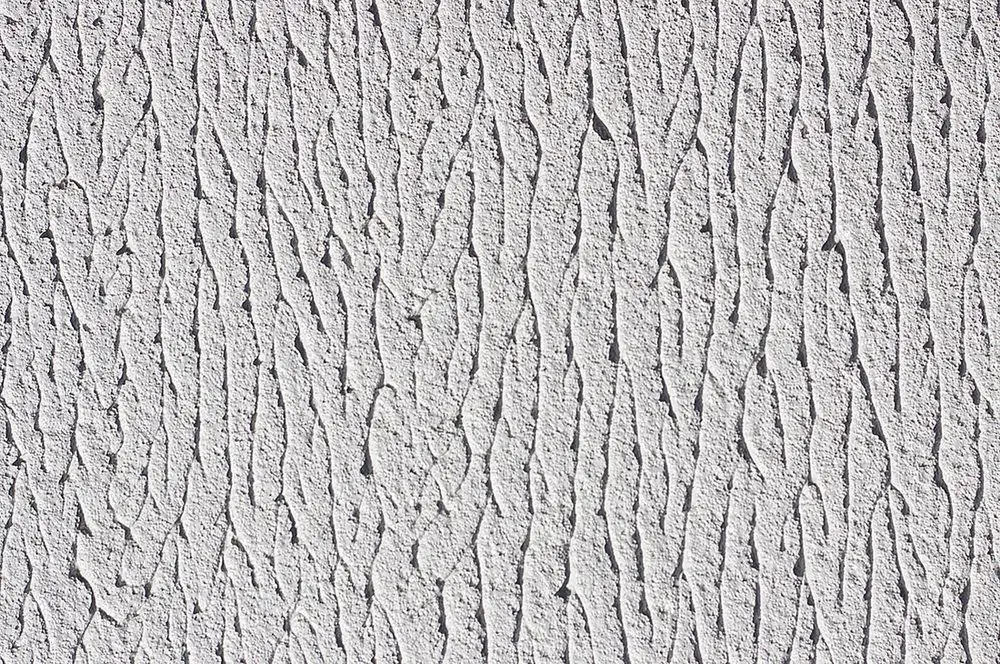
Reviews of masters about the ironer
Professional plasterers note that the tool can be useful in working with problematic compositions, when it is necessary to perform accurate laying of the mixture in a short period of time due to rapid polymerization. An ordinary spatula will take more time due to its smaller size, and it is not always convenient to use the rule in a normal room. Therefore, the versatility of the plaster trowel is put in the first place. However, from the point of view of ergonomics, this is not the best choice, since the large size of the working part does not allow minor improvements in hard-to-reach areas and corners. One way or another, experts point to the justification for such an acquisition for both household and professional tasks. A high-quality trowel is not cheap for its purpose - about 500-600 rubles, but a good result of work in capable hands will be guaranteed.
Conclusion
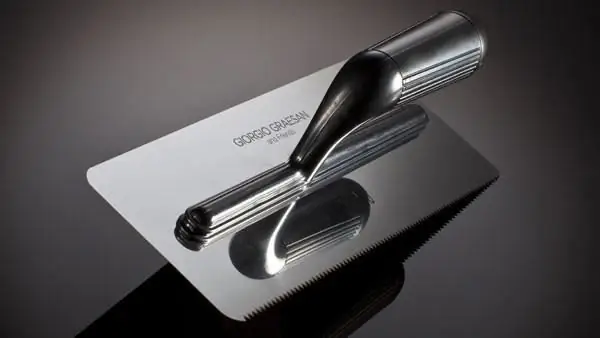
The Venetian spatula shows an example of a very common tool for laying various plaster mixtures. On this base, various modifications are produced, designed specifically for grouting, for processing slopes, for corner joints, etc. In the standard version, the trowel for Venetian plaster can be useful both when laying the primer base and for finishing leveling. The wide working area allows you to keep under control large masses of solution, which speeds up the workflow and provides a more pronounced leveling effect. But, again, it will not be superfluous to have on hand a couple of auxiliary trowels and trowels forsmall intermediate operations that the ironer cannot handle.






